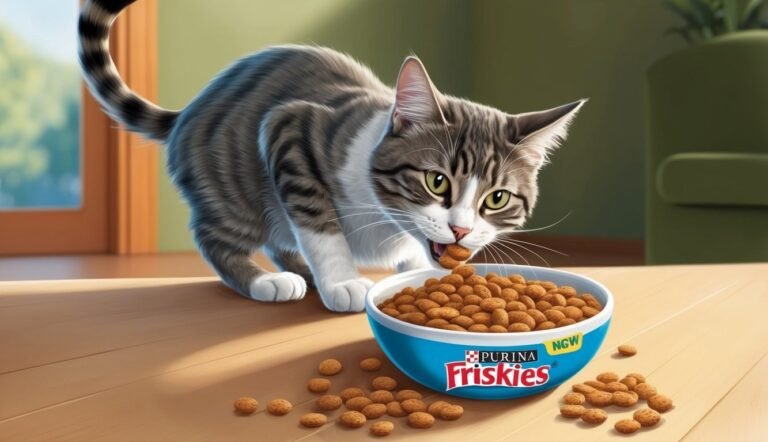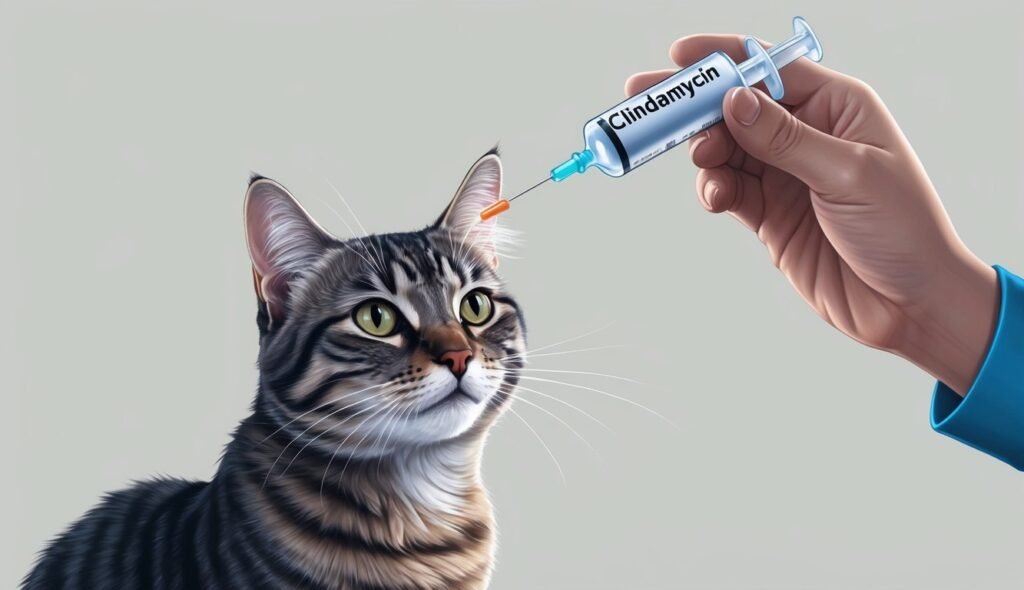When considering cat food options, Friskies by Purina offers a variety of affordable products that many pet owners find appealing.
But, is it the right choice for your feline friend? With a variety of wet and dry food options, Friskies caters to different tastes and budgets, making it popular among cat owners.
However, you may also want to consider the nutritional content and potential drawbacks before making a decision.
Friskies meets AAFCO nutritional standards, providing your cat with essential nutrients.
That said, some owners have reported concerns about specific ingredients.
These could lead to digestive issues or allergic reactions in certain cats.
In this article, we’ll break down the benefits and risks of feeding your cat Friskies, along with what other pet owners have experienced.
As you explore this topic, you’ll gain insights on whether Friskies aligns with your cat’s health needs and preferences.
It’s vital to take a closer look at both the positive feedback and the potential drawbacks to ensure you’re making an informed decision for your furry companion.
Key Takeaways
- Friskies offers a variety of affordable options for pet owners.
- Nutritional content meets basic standards, but some ingredients may raise concerns.
- Customer feedback highlights a mix of positive experiences and potential issues.
Overview of Friskies Cat Food
Friskies is a well-known cat food brand under Purina, offering a variety of options for your feline friend.
You can choose from dry food, wet food, and many different flavors to suit your cat’s taste.
Product Varieties
Friskies provides:
- Dry Cat Food: Often more budget-friendly, costing around $0.18 per day for a 10-lb cat.
- Wet Cat Food: Slightly more expensive, with costs averaging $0.95 per day.
Ingredients
Friskies products often market ingredients such as chicken, salmon, and cheese.
However, it’s essential to note that some formulas may not contain as many high-quality ingredients as advertised.
Always check the labels for specifics.
Nutrition and Quality
While many cat owners appreciate Friskies for its affordability and variety, the nutritional quality can vary.
It’s advisable to look for recipes with real protein sources as the first ingredient for a healthier option.
Friskies caters to a wide audience, making it accessible for most pet parents.
Its broad range of flavors can help you find something your cat will love.
Nutrition and Ingredients Analysis
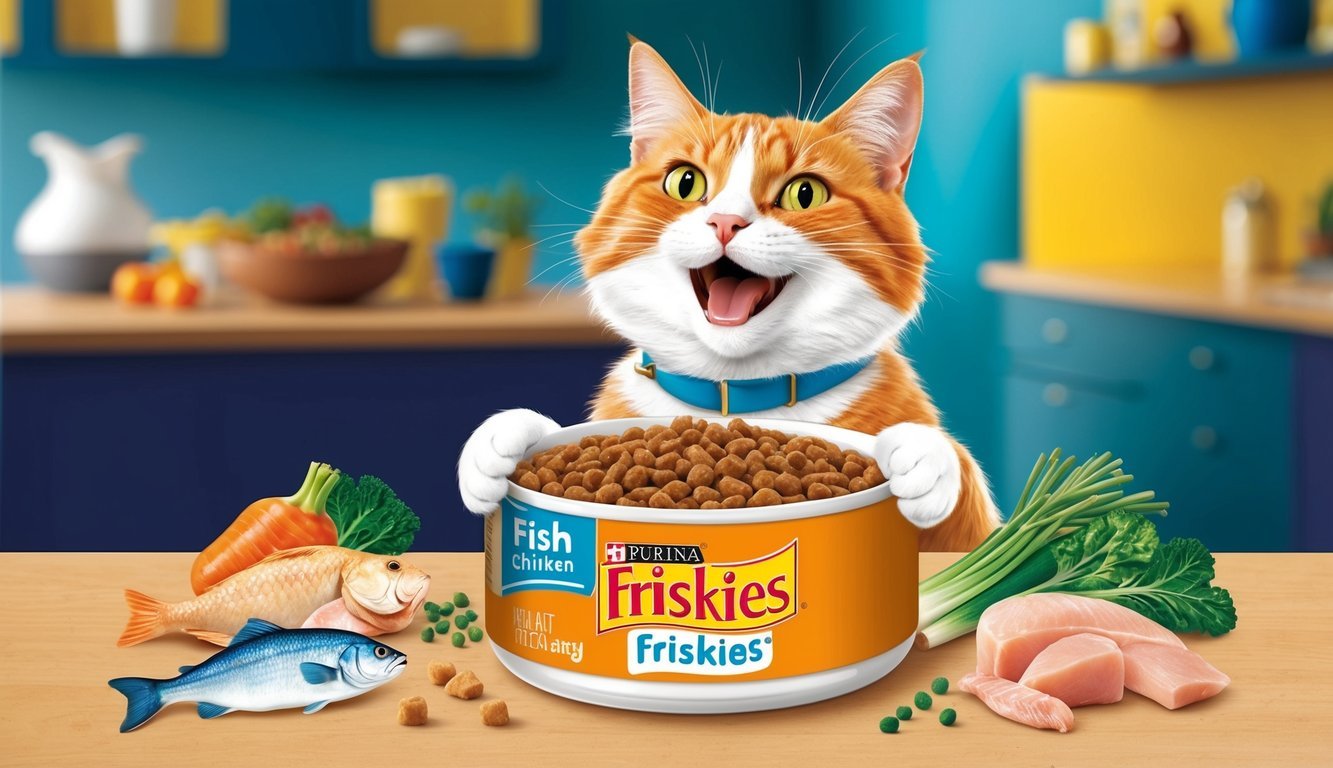
When evaluating Purina Friskies for your cat, it’s essential to look closely at its nutritional components and ingredient quality.
You’ll find a mix of protein sources, carbohydrate content, and additives that may influence your decision.
Protein Content and Sources
Protein is crucial for your cat’s overall health since they are obligate carnivores.
Friskies offers a protein content of around 50% in its wet foods.
The protein primarily comes from meat and meat by-products, which can vary in quality.
Key Protein Sources:
- Chicken
- Turkey
- Liver and other by-products
While some cats may do well on by-products, it’s important to consider that these can include lower-quality parts of the animal.
You may want to look for options containing named meats like “chicken” instead of generic terms like “meat by-products” for better assurance of quality.
Carbohydrates and Grain Content
Friskies is notable for its higher carbohydrate content, which can be concerning for some cat owners.
The brand often utilizes corn, wheat, and soy as fillers.
Typical Carbohydrate Sources:
- Corn gluten meal
- Wheat
- Soybean meal
These ingredients can contribute to obesity and other health issues in some cats.
If your cat is prone to weight gain or has specific dietary needs, you might want to monitor carbohydrate intake closely.
Additives and Artificial Colors
Friskies contains various additives and artificial colors to enhance flavor and appearance.
The presence of these ingredients can be a drawback for cat owners seeking natural options.
Common Additives:
- Flavor enhancers
- Preservatives
- Artificial colors
Some additives may not contribute to nutritional value and can lead to health concerns over time.
Choosing products with fewer artificial ingredients can help ensure your cat gets a more wholesome diet.
Always check the ingredient list to make informed decisions about what you’re feeding your cat.
Balanced Diet and Nutritional Needs
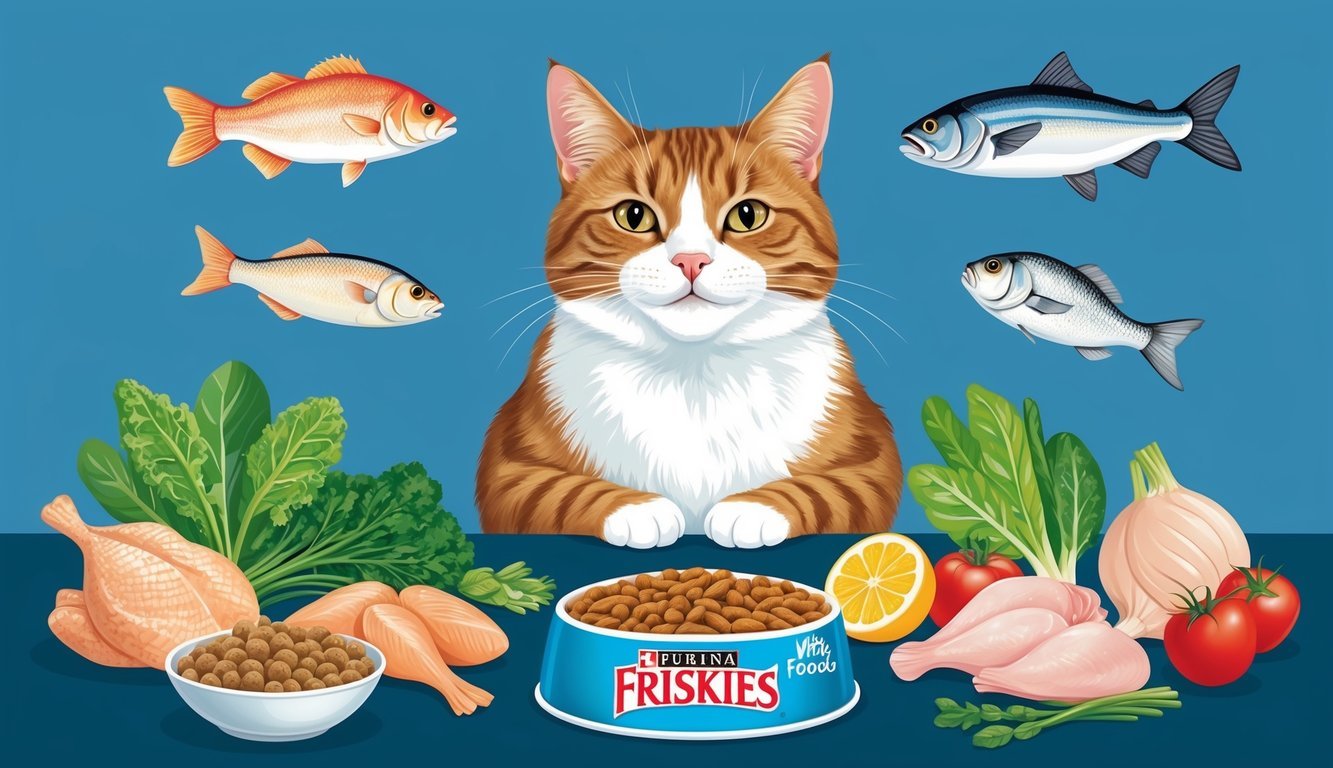
When considering whether Purina Friskies is a good choice for your cat, it’s essential to understand its nutritional offerings and how they align with your pet’s specific dietary requirements.
Let’s explore how Friskies meets established standards and how it may cater to your cat’s needs.
Meeting AAFCO Standards
Purina Friskies aims to meet the nutritional standards set by the Association of American Feed Control Officials (AAFCO).
This non-profit organization establishes guidelines that ensure pet foods provide adequate nutrition for various life stages.
Friskies cat food typically undergoes feeding trials to ensure compliance, which supports its claim of balanced nutrition.
Look for labels stating that a product meets AAFCO standards, as this is a good indication of nutritional value.
Understanding Cat Dietary Needs
Cats are obligate carnivores, meaning they require a diet rich in proteins.
Your cat’s diet should have a balance of:
- Protein: Vital for muscle, tissue repair, and overall health.
- Fats: Provide energy and support skin and coat health.
- Vitamins and Minerals: Essential for various bodily functions.
A balanced meal for your cat should include a mix of these nutrients to support its overall health.
Friskies offers numerous flavors and formulations, but check the nutritional content to ensure it aligns with your cat’s unique dietary needs.
If your cat has any specific sensitivities or allergies, consult your veterinarian when selecting food.
Health and Safety Standards

When considering Purina Friskies for your cat, it’s important to understand the brand’s commitment to health and safety.
This involves robust quality control measures and a history of recalls, ensuring that your cat’s nutrition is both safe and reliable.
Quality Control Measures
Purina Friskies places a strong emphasis on rigorous quality control throughout its production processes.
Every ingredient is carefully sourced and evaluated to meet safety and nutritional standards.
- Ingredient Sourcing: Only high-quality ingredients are selected to ensure your cat receives balanced nutrition tailored to their needs.
- Safety Protocols: The company employs stringent testing for harmful substances and artificial additives that could affect your pet’s health.
For cats with sensitive stomachs or dietary restrictions, these measures help minimize health concerns and support digestive health.
Recall History and FDA Compliance
While no brand is entirely free from recalls, Purina Friskies has a transparent recall history.
They work closely with the FDA to address any issues swiftly.
- Recall Management: When recalls occur, affected products are promptly removed from shelves, and pet owners are informed. This quick response ensures your cat’s safety is prioritized.
- FDA Standards: Purina complies with all FDA regulations, reinforcing its commitment to providing high-quality nutrition without compromising safety.
By staying informed about recalls and adhering to strict guidelines, Purina strives to maintain the highest health standards for your feline companion.
Product Range and Options

Purina Friskies offers a diverse selection of cat food options tailored to meet the needs of your feline companion.
This includes both canned and dry products, with various flavors designed for different tastes and life stages.
Canned vs. Dry: What’s Available?
When it comes to feeding your cat, you typically have two primary choices: canned and dry food. Canned products often provide higher moisture content, which can be beneficial for hydration.
These options are available in classic paté and chunk varieties.
Dry food, on the other hand, tends to be more economical.
For example, feeding your cat a 10-lb adult may cost around $0.95 per day for canned food, while dry food can be as low as $0.18 daily.
Friskies also has a variety of both types, ensuring good choices for any budget or preference.
Flavors, Varieties, and Life Stages
Friskies caters to your cat’s taste buds with a wide range of flavors.
You’ll find options featuring seafood, chicken, turkey, and beef, ensuring there’s something for every palate.
Additionally, Friskies offers products formulated for specific life stages, including kitten, adult, and senior formulas.
Each is crafted to provide the right balance of nutrients necessary for your cat’s health.
Popular varieties include Seafood Sensations and various paté dinners that keep mealtime exciting for your pet.
With such a breadth of choices, you can easily find the perfect match for your cat’s needs and preferences.
Affordability and Value for Money
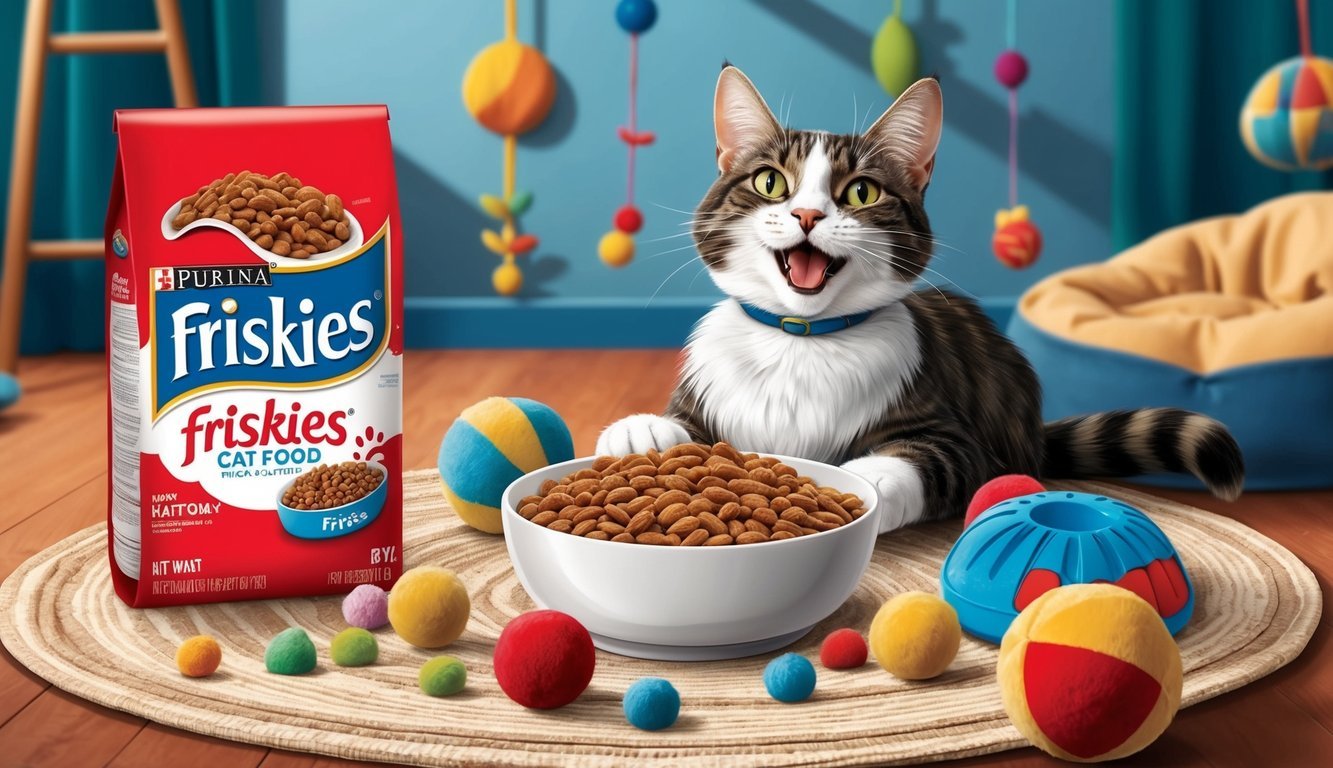
When considering cat food, affordability is often a top priority for many pet owners.
Purina Friskies offers a wide range of products that cater to various budgets.
For example, the price of Friskies dry food typically ranges from $16.99 to $29.99.
In contrast, the canned products are generally pricier, costing around $0.95 per day for a 10-pound cat.
Here’s a quick comparison of costs for different formats:
| Product Type | Approximate Cost per Day |
|---|---|
| Dry Food | $0.18 |
| Canned Food | $0.95 |
You might find that Friskies offers good value for money, especially if you’re looking for budget-friendly options without compromising on basic nutritional needs.
While options like Purina generally promote higher quality ingredients, Friskies provides a more economical alternative.
Many cat owners appreciate how Friskies fits into their budgets while still providing a reasonable level of nutrition.
It’s a practical choice when you want to balance costs with feeding your furry friend well.
If you aim for quality without a hefty price tag, Friskies makes it possible to care for your cat’s health without breaking the bank.
Customer Experience and Feedback
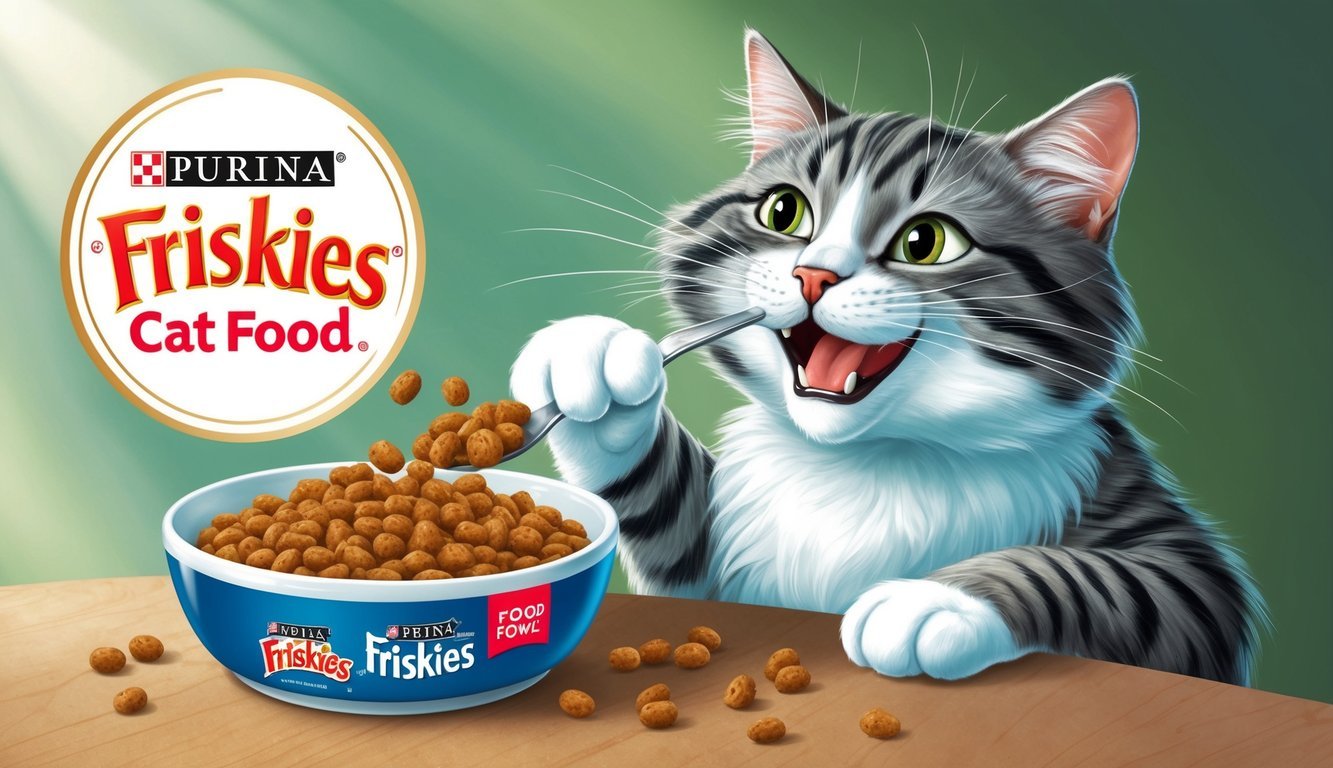
Customer experiences with Purina Friskies often reflect a mixture of satisfaction and concerns.
Many cat owners share insights about their pets’ preferences and how well the food meets their nutritional needs.
Reviews highlight aspects like taste, variety, and affordability.
Reviews and Consumer Trust
Many cat owners report positive experiences with Friskies, particularly appreciating the wide range of flavors.
Taste tests show that most cats enjoy the wet food options, which can be a hit or miss depending on individual preferences.
- Positive Feedback: Many users feel their cats thrive on Friskies, noting improved energy and coat quality.
- Concerns: Some consumers mention that ingredient transparency could be enhanced. A few reviews point out discrepancies in advertised versus actual ingredient quality.
Overall, while most reviews reflect a level of trust in the brand, concerns about ingredient sourcing and nutritional balance lead some to seek alternatives.
Comparative Analysis With Other Brands

When evaluating Purina Friskies against competitors, it’s essential to consider factors such as nutritional content, ingredients, and price.
Here’s how Friskies stacks up against popular brands like 9 Lives, Blue Buffalo, Hill’s Science Diet, and Royal Canin.
Friskies vs. 9 Lives
Friskies and 9 Lives are both well-known brands offering affordable options in the cat food market.
Friskies tends to have a broader variety of flavors, appealing to picky eaters.
The proteins in Friskies average around 30%, while 9 Lives similarly provides a protein content of about 28%.
Price Comparison:
- Friskies: $1.20 – $1.50 per can
- 9 Lives: $1.00 – $1.30 per can
While Friskies offers more flavor variety, 9 Lives may appeal to budget-conscious pet parents.
However, the nutritional value and ingredient quality can vary significantly, with Friskies often criticized for higher carbohydrate content.
Friskies vs. Blue Buffalo
Blue Buffalo is renowned for using high-quality, natural ingredients.
While Friskies provides a more economical choice, Blue Buffalo focuses on premium quality.
Nutritional Breakdown:
- Friskies: Approximately 30% protein, with fillers like corn and wheat.
- Blue Buffalo: Features a higher average of 38% protein, prioritizing real meat as the first ingredient.
If you’re looking for higher nutritional standards and your cat’s diet leans toward premium food, Blue Buffalo is an excellent choice.
The price, however, reflects the quality, with Blue Buffalo costing significantly more than Friskies.
Friskies vs. Hill’s Science Diet
Hill’s Science Diet is often recommended by veterinarians, focusing on specialized nutrition.
While Friskies offers a variety of flavors, Hill’s emphasizes health benefits tailored to specific needs, such as weight management and digestive health.
Key Differences:
- Friskies: Average of 30% protein and higher carb content.
- Hill’s Science Diet: About 35% protein, with balanced nutrients tailored for various life stages.
If your cat has particular health concerns, Hill’s Science Diet may be the better option, though it comes at a higher price point than Friskies.
Friskies vs. Royal Canin
Royal Canin is another premium brand that tailors food to specific breeds and dietary needs.
This brand is often higher in quality compared to Friskies, with a focus on scientifically formulated nutrition.
Nutritional Considerations:
- Friskies: Average of 30% protein with lower-quality fillers.
- Royal Canin: Typically features 30% or more protein, prioritizing digestibility and nutrient absorption.
While Royal Canin can be more expensive, you may find the specialized approach beneficial for your cat’s health needs.
Friskies, meanwhile, provides a versatile and affordable option for everyday feeding.
Specific Dietary Considerations

When selecting cat food, it’s important to focus on key dietary factors that cater to your cat’s specific needs.
This involves looking at fatty acids, grain content, and urinary health.
Omega Fatty Acids and Nutritional Supplements
Omega fatty acids, specifically omega-3 and omega-6, play a crucial role in your cat’s health.
These essential fats contribute to a shiny coat, healthy skin, and optimal brain function.
Purina Friskies often includes these fatty acids, but it’s vital to check the ingredient list.
Look for fish oil or flaxseed oil as sources of omega-3.
Additionally, consider nutritional supplements like taurine, an amino acid important for heart and eye health.
If you choose a supplement, consult your vet to ensure it complements your cat’s diet appropriately.
Grain-Free Options for Sensitive Cats
Some cats may experience sensitivities to grains, which can lead to digestive issues.
If your cat shows signs of gastrointestinal discomfort, you might want to consider grain-free options.
Purina Friskies offers grain-free varieties that can be beneficial in these cases.
These options are formulated to meet the nutritional requirements of obligate carnivores while omitting grains like corn and wheat.
Always introduce new foods gradually to monitor how your cat reacts to ensure their dietary needs are met without any adverse effects.
Maintaining Urinary Health
Cats are susceptible to urinary tract issues, making urinary health a top priority.
To support this, look for cat foods that promote hydration and balance urinary pH levels.
Purina Friskies formulates some products with these considerations in mind, often incorporating moisture-rich ingredients.
Additionally, ensure your cat has access to fresh water at all times.
If you’re concerned about urinary health, discussing dietary options with your veterinarian can help you select the best food for your cat’s specific needs.
Frequently Asked Questions
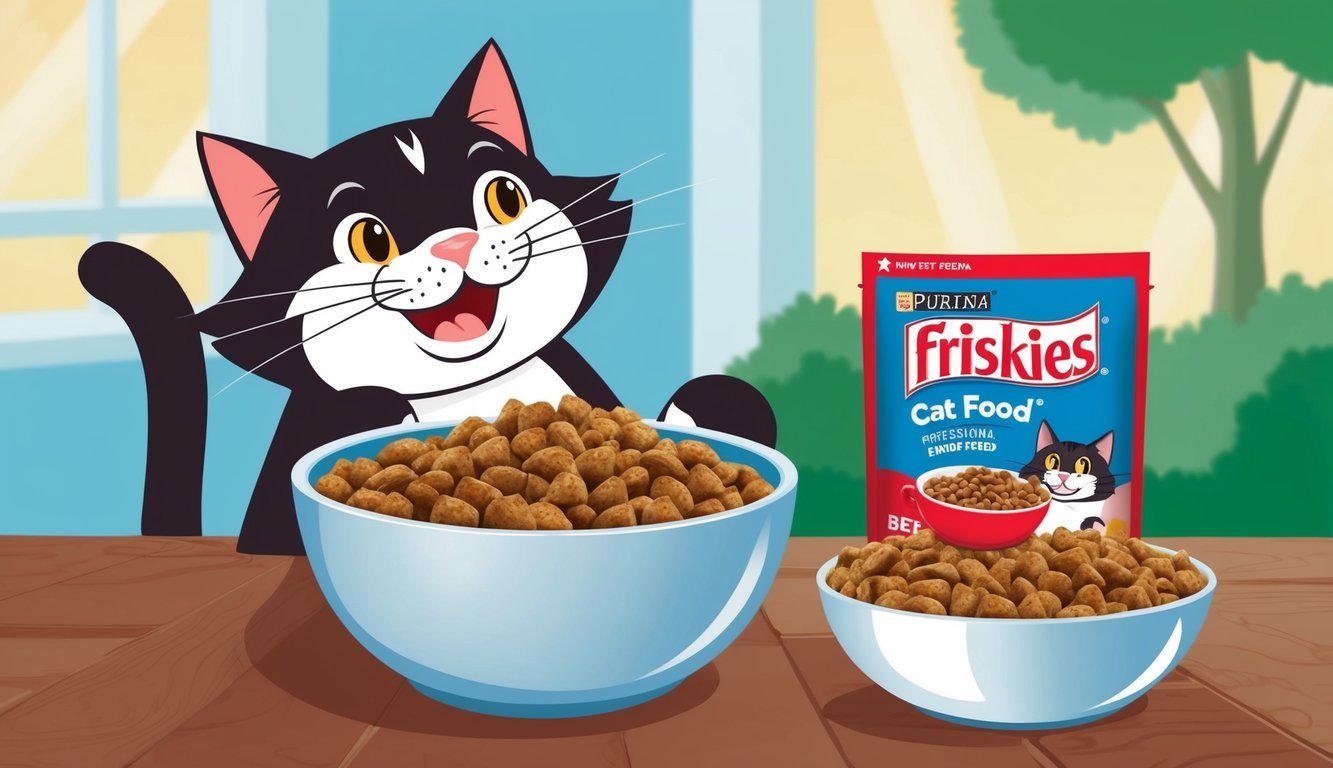
You might have some questions about Purina Friskies and how it fits into your cat’s diet.
Understanding the nutritional benefits, any reported issues, and comparisons with other brands can guide your choices.
What are the nutritional benefits of Friskies wet and dry cat food?
Friskies offers both wet and dry food options that aim to provide balanced nutrition for your cat.
They include essential vitamins and minerals that support your cat’s overall health.
Ingredients are selected for their nutritional value, which can help keep your cat active and healthy.
Have cat owners reported any issues with Friskies brand cat foods?
Some cat owners have noted concerns about specific ingredients in Friskies, such as carrageenan, which reportedly caused digestive issues in some cats.
While many find it suitable for their pets, personal experiences vary, and it’s essential to monitor your cat for any adverse reactions.
How does Friskies compare to other brands like Fancy Feast in terms of quality?
Friskies is often viewed as a budget-friendly option, whereas brands like Fancy Feast may offer premium formulations.
Both brands aim to provide complete nutrition, but differences in ingredients and price may influence your decision based on your cat’s needs and your budget.
Are there specific Friskies products recommended for kittens?
Yes, Friskies produces specific formulas designed for kittens.
These products typically contain higher protein levels and vital nutrients that support growth and development in young cats.
Always check the label for age-appropriate nutrition.
Can serving Friskies canned food improve my cat’s health?
Feeding your cat Friskies canned food can contribute to hydration because of its higher moisture content compared to dry food.
It’s also a source of protein and other essential nutrients.
Many cats enjoy the taste, which can encourage better eating habits.
What do the latest reviews say about Friskies wet cat food?
Recent reviews indicate that cats generally like Friskies wet cat food.
Owners often appreciate the variety of flavors and textures offered.
Some reviewers highlight value for money while noting occasional concerns regarding ingredient quality.
This can vary depending on individual preferences and cat reactions.

